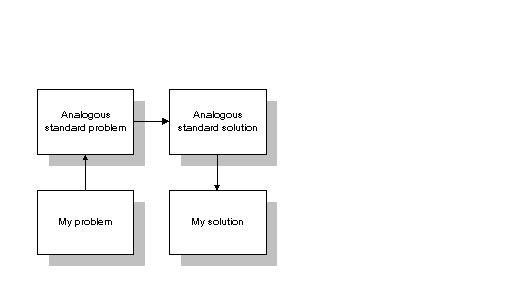
Following World War II, the high quality, technologically advanced
products of the United States dominated world markets. With the
oil shock of the 1970s, however, many of the economic advantages
associated with cheap petroleum were lost and the recovered economies
of Europe and Asia emerged as strong competitors in many product
areas. The innovative technologies of the US could no longer insulate
industries from the customer oriented approaches of European and
Asian producers.
The 1990s have seen the recovery of many US industries, most notably
the automotive industry. This has been due in part to the influence
of many Japanese quality methodologies introduced here by the
late Dr. Kaoru Ishikawa, Dr. Masao Kogure, Dr. Yoji Akao, Dr.
Noriaki Kano, Mr. Masaaki Imai, and many others. These quality
methods have helped US industries reduce defects, improve quality,
lower costs, and become more customer focused. As the quality
gap with countries like Japan gets smaller, the US is looking
for new approaches to assure customer satisfaction, reduce costs,
and bring products to the market faster. In the US, we say "better,
cheaper, faster."
While there are many widely used design and development approaches
such as Quality Function Deployment, these show us what
to solve but not always how to solve the technology bottlenecks
that arise. One technique, the Reviewed Dendrogram, relies on
the experience of designers which may be limited to certain areas
of expertise such as chemistry or electronics. Thus, a solution
that might be simpler and cheaper using magnetism could be missed.
For example, a materials engineer searching for a dampener may
limit his search to rubber based materials. A more efficient solution
might lie in creating a magnetic field. Since this is outside
the experience of the engineer, how could he imagine such a solution?
Using TRIZ, he would be able to explore design solutions in fields
other than his own.
Rockwell International's Automotive Division faced a problem like
this. They were losing a competitive battle with a Japanese company
over the design of brakes for a golf cart. Since both Rockwell
and the Japanese competitor were in the automotive field, they
were competing on redesigns of an automobile brake system but
with smaller components. In TRIZ, this seeking solutions only
in one's field is called "psychological inertia" because
it is natural for people to rely on their own experience and not
think outside their specialty. With TRIZ, the problem was solved
by redesigning a bicycle brake system with larger components.
The result was a part reduction from twelve to four parts and
a cost savings of 50%.
There are two groups of problems people face: those with generally
known solutions and those with unknown solutions. Those with known
solutions can usually be solved by information found in books,
technical journals, or with subject matter experts. These solutions
follow the general pattern of problem solving shown in figure
1. Here, the particular problem is elevated to a standard problem
of a similar or analogous nature. A standard solution is known
and from that standard solution comes a particular solution to
the problem. For example, in designing a rotating cutting machine(my
problem), a powerful but low 100 rpm motor is required. Since
most AC motors are high rpm (3600 rpm), the analogous standard
problem is how to reduce the speed of the motor. The analogous
standard solution is a gear box or transmission. Then, a gear
box can be designed with appropriate dimensions, weight, rpm,
torque, etc. can be designed for my cutting needs.

|
| Figure 1. General Problem Solving Model. |
The other type of problem is one with no known solution. It is
called an inventive problem and may contain contradictory requirements.
As long ago as the 4th century, an Egyptian scientist
named Papp suggested there should be a science called heuristics
to solve inventive problems. In modern times, inventive problem
solving has fallen into the field of psychology where the links
between the brain and insight and innovation are studied. Methods
such as brainstorming and trial-and-error are commonly suggested.
Depending on the complexity of the problem, the number of trials
will vary. If the solution lies within one's experience or field,
such as mechanical engineering, than the number of trials will
be fewer. If the solution is not forthcoming, then the inventor
must look beyond his experience and knowledge to new fields such
as chemistry or electronics. Then the number of trials will grow
large depending on how well the inventor can master psychological
tools like brainstorming, intuition, and creativity. A further
problem is that psychological tools like experience and intuition
are difficult to transfer to other people in the organization.
This leads to what is called psychological inertia, where the
solutions being considered are within one's own experience and
do not look at alternative technologies to develop new concepts.
This is shown by the psychological inertia vector in figure 2.
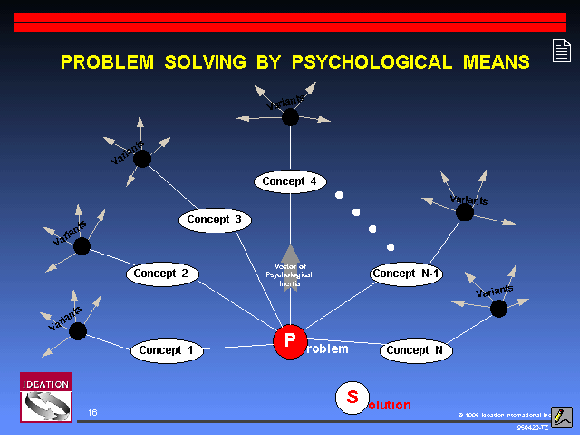 |
When we overlay the limiting effects of psychological inertia
on a solution map covering broad scientific and technological
disciplines, we find that the ideal solution may lie outside the
inventor's field of expertise. This is seen in figure 3 where
the ideal solution is electromechanical but is outside the experience
of the mechanical engineer and so remains untried and may even
be invisible. If problem solving was a random process, then we
would expect solutions to occur randomly across the solution space.
Psychological inertia defeats randomness and leads to looking
only where there is personal experience.
|
|
A better approach, relying not on psychology but on technology
was developed by Genrich S. Altshuller, born in the former Soviet
Union in 1926. His first invention, for scuba diving, was when
he was only 14 years old. His hobby led him to pursue a career
as a mechanical engineer. Serving in the Soviet Navy as a patent
expert in the 1940s, his job was to help inventors apply for patents.
He found, however, that often he was asked to assist in solving
problems as well. His curiosity about problem solving led him
to search for standard methods. What he found were the psychological
tools that did not meet the rigors of inventing in the 20th
century. At a minimum, Altshuller felt a theory of invention should
satisfy the following conditions:
In the next few years, Altshuller screened over 200,000 patents
looking for inventive problems and how they were solved. Of these
(over 1,500,000 patents have now been screened), only 40,000 had
somewhat inventive solutions; the rest were straight forward improvements.
Altshuller more clearly defined an inventive problem as one in
which the solution causes another problem to appear, such as increasing
the strength of a metal plate causing its weight to get heavier.
Usually, inventors must resort to a trade-off and compromise between
the features and thus do not achieve an ideal solution. In his
study of patents, Altshuller found that many described a solution
that eliminated or resolved the contradiction and required no
trade-off.
Altshuller categorized these patents in a novel way. Instead of
classifying them by industry, such as automotive, aerospace, etc.,
he removed the subject matter to uncover the problem solving process.
He found that often the same problems had been solved over and
over again using one of only forty fundamental inventive principles.
If only later inventors had knowledge of the work of earlier ones,
solutions could have been discovered more quickly and efficiently.
In the 1960s and 1970s, he categorized the solutions into five
levels.
He also noted that with each succeeding level, the source of the
solution required broader knowledge and more solutions to consider
before an ideal one could be found. His findings are summarized
in Table 1.
| Apparent solution | Personal knowledge | |||
| Minor improvement | Knowledge within company | |||
| Major improvement | Knowledge within the industry | |||
| New concept | Knowledge outside the industry | |||
| Discovery | All that is knowable | |||
What Altshuller tabulated was that over 90% of the problems engineers
faced had been solved somewhere before. If engineers could follow
a path to an ideal solution, starting with the lowest level, their
personal knowledge and experience, and working their way to higher
levels, most of the solutions could be derived from knowledge
already present in the company, industry, or in another industry.
For example, a problem in using artificial diamonds for tool making
is the existence of invisible fractures. Traditional diamond cutting
methods often resulted in new fractures which did not show up
until the diamond was in use. What was needed was a way to split
the diamond crystals along their natural fractures without causing
additional damage. A method used in food canning to split green
peppers and remove the seeds was used. In this process, peppers
are placed in a hermetic chamber to which air pressure is increased
to 8 atmospheres. The peppers shrink and fracture at the stem.
Then the pressure is rapidly dropped causing the peppers to burst
at the weakest point and the seed pod to be ejected. A similar
technique applied to diamond cutting resulted in the crystals
splitting along their natural fracture lines with no additional
damage.
Altshuller distilled the problems, contradictions, and solutions
in these patents into a theory of inventive problem solving which
he named TRIZ.
There are a number of laws in the theory of TRIZ. One of them
is the Law of Increasing Ideality. This means that technical systems
evolve toward increasing degrees of ideality, where ideality is
defined as the quotient of the sum of the system's useful effects,
Ui, divided by the sum of its harmful effects, Hj.

Useful effects include all the valuable results of the system's
functioning. Harmful effects include undesired inputs such as
cost, footprint, energy consumed, pollution, danger, etc. The
ideal state is one where there are only benefits and no harmful
effects. It is to this state that product systems will evolve.
From a design point of view, engineers must continue to pursue
greater benefits and reduce cost of labor, materials, energy,
and harmful side effects. Normally, when improving a benefit results
in increased harmful effects, a trade-off is made, but the Law
of Ideality drives designs to eliminate or solve any trade-offs
or design contradictions. The ideal final result will eventually
be a product where the beneficial function exists but the machine
itself does not. The evolution of the mechanical spring-driven
watch into the electronic quartz crystal watch is an example of
moving towards ideality.
As mentioned above, Altshuller felt an acceptable theory of invention
should be familiar enough to inventors by following the general
approach to problem solving shown in figure 1. A model was constructed
as shown in figure 4.
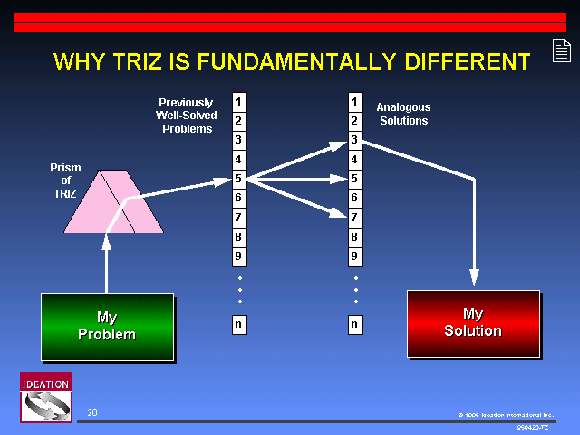 |
Boris Zlotin and Alla Zusman, principles TRIZ scientists at the American company Ideation and students of Altshuller have developed an "Innovative Situation Questionnaire" to identify the engineering system being studied, its operating environment, resource requirements, primary useful function, harmful effects, and ideal result.
Example: A beverage can. An engineered
system to contain a beverage. Operating environment is that cans
are stacked for storage purposes. Resources include weight of
filled cans, internal pressure of can, rigidity of can construction.
Primary useful function is to contain beverage. Harmful effects
include cost of materials and producing can and waste of storage
space. Ideal result is a can that can support the weight of stacking
to human height without damage to cans or beverage in cans.
Restate the problem in terms of physical contradictions. Identify problems that could occur. Could improving one technical characteristic to solve a problem cause other technical characteristics to worsen, resulting in secondary problems arising? Are there technical conflicts that might force a trade-off?
Example: We cannot control the height to which
cans will be stacked. The price of raw materials compels us to
lower costs. The can walls must be made thinner to reduce costs,
but if we make the walls thinner, it cannot support as large a
stacking load. Thus, the can wall needs to be thinner to lower
material cost and thicker to support stacking-load weight. This
is a physical contradiction. If we can solve this, we will achieve
an ideal engineering system.
Altshuller extracted from over 1,500,000 world-wide patents these 39 standard technical characteristics that cause conflict. These are called the 39 Engineering Parameters shown in Table 2. Find the contradicting engineering principles. First find the principle that needs to be changed. Then find the principle that is an undesirable secondary effect. State the standard technical conflict.
Example. The standard engineering parameter that
has to be changed to make the can wall thinner is "#4, length
of a nonmoving object." In TRIZ, these standard engineering
principles can be quite general. Here, "length" can
refer to any linear dimension such as length, width, height, diameter,
etc. If we make the can wall thinner, stacking-load weight will
decrease. The standard engineering parameter that is in conflict
is "#11, stress."
The standard technical conflict is: the more we improve the standard engineering parameter "length of a nonmoving object," the more the standard engineering parameter "stress" becomes worse.
Table 2. The 39 Engineering Parameters
Altshuller also extracted from the world wide patents 40 inventive principles. These are hints that will help an engineer find a highly inventive (and patentable) solution to the problem. Examples from patents are also suggested with these 40 inventive principles. See Table 3. To find which inventive principles to use, Altshuller created the Table of Contradictions, Table 4. The Table of Contradictions lists the 39 Engineering Parameters on the X-axis (undesired secondary effect) and Y-axis (feature to improve). In the intersecting cells, are listed the appropriate Inventive Principles to use for a solution.
Example. The engineering parameters in conflict
for the beverage can are "#4, length of a nonmoving object"
and "#11, stress." The feature to improve (Y-axis) is
the can wall thickness or "#4, length of a nonmoving object"
and the undesirable secondary effect (X-axis) is loss of load
bearing capacity or "#11, stress." Looking these up
on the Table of Contradictions, we find the numbers 1, 14, and
35 in the intersecting cell.
Inventive Principle #1 is
Segmentation
a. Divide an object into independent parts
b. Make an object sectional
c. Increase the degree of an object's segmentation
Examples:
For example, using Inventive Principle 1 c. "Increase the degree of an object's segmentation," the wall of the can could be changed from one smooth continuous wall to a corrugated or wavy surface made up of many "little walls." This would increase the edge strength of the wall yet allow a thinner material to be used. See figure 5.
 Figure 5. Cross section of corrugated can wall. Figure 5. Cross section of corrugated can wall. |
Inventive Principle # 14 is
Spheroidality
a. Replace linear parts or flat surfaces with curved ones; replace cubical shapes with spherical shapes
b. Use rollers, balls spirals
c. Replace a linear motion with rotating movement; utilize a centrifugal force
Example:
Using Inventive Principle 14 a., the perpendicular angle at
which most can lids are welded to the can wall can be changed
to a curve. See figure 6.
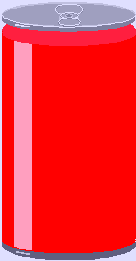 |
|
Inventive Principle #35 is
Transformation of the physical and chemical states of an object
Change an object's aggregate state, density distribution, degree of flexibility, temperature
Example:
Change the composition to a stronger metal alloy used for the
can wall to increase the load bearing capacity.
In less than one week, the inventor Jim Kowalik of Renaissance
Leadership Institute was able to propose over twenty usable solutions
to the U.S. canned beverage industry, several which have been
adopted.
1. Segmentation
a. Divide an object into independent parts
b. Make an object sectional
c. Increase the degree of an object's segmentation
Examples:
2. Extraction
a. Extract (remove or separate) a "disturbing" part or property from an object, or
b. Extract only the necessary part or property
Example:
3. Local Quality
a. Transition from a homogeneous structure of an object or outside environment/action to a heterogeneous structure
b. Have different parts of the object carry out different functions
c. Place each part of the object under conditions most favorable for its operation
Examples:
4. Asymmetry
a. Replace a symmetrical form with an asymmetrical form.
b. If an object is already asymmetrical, increase the degree of asymmetry
Examples:
5. Combining
a. Combine in space homogeneous objects or objects destined for contiguous operations
b. Combine in time homogeneous or contiguous operations
Example:
6. Universality
Have the object perform multiple functions, thereby eliminating the need for some other object(s)
Examples:
7. Nesting
a. Contain the object inside another which, in turn, is placed inside a third object
b. Pass an object through a cavity of another object
Examples:
8. Counterweight
a. Compensate for the object's weight by joining with another object that has a lifting force
b. Compensate for the weight of an object by interaction with an environment providing aerodynamic or hydrodynamic forces
Examples:
9. Prior counter-action
a. Perform a counter-action in advance
b. If the object is (or will be) under tension, provide anti-tension in advance
Examples:
10. Prior action
a. Carry out all or part of the required action in advance
b. Arrange objects so they can go into action in a timely matter and from a convenient position
Examples:
11. Cushion in advance
Compensate for the relatively low reliability of an object by countermeasures taken in advance
Example:
12. Equipotentiality
Change the working conditions so that an object need not be raised or lowered.
Example:
13. Inversion
a. Instead of an action dictated by the specifications of the problem, implement an opposite action
b. Make a moving part of the object or the outside environment immovable and the non-moving part movable
c. Turn the object upside-down
Example:
14. Spheroidality
a. Replace linear parts or flat surfaces with curved ones; replace cubical shapes with spherical shapes
b. Use rollers, balls spirals
c. Replace a linear motion with rotating movement; utilize a centrifugal force
Example:
15. Dynamicity
a. Make an object or its environment automatically adjust for optimal performance at each stage of operation
b. Divide an object into elements which can change position relative to each other
c. If an object is immovable, make it movable or interchangeable
Examples:
16. Partial or overdone action
If it is difficult to obtain 100% of a desired effect, achieve somewhat more or less to greatly simplify the problem
Examples:
17. Moving to a new dimension
a. Remove problems with moving an object in a line by two-dimensional movement (i.e. along a plane)
b. Use a multi-layered assembly of objects instead of a single layer
c. Incline the object or turn it on its side
Example:
18. Mechanical vibration
a. Set an object into oscillation
b. If oscillation exists, increase its frequency, even as far as ultrasonic
c. Use the resonant frequency
d. Instead of mechanical vibrations, use piezovibrators
e. Use ultrasonic vibrations in conjunction with an electromagnetic field
Examples:
19. Periodic action
a. Replace a continuous action with a periodic (pulsed) one
b. If an action is already periodic, change its frequency
c. Use pulsed between impulses to provide additional action
Examples:
20. Continuity of a useful action
a. Carry out an action continuously (i.e. without pauses), where all parts of an object operate at full capacity
b. Remove idle and intermediate motions
Example:
21. Rushing through
Perform harmful or hazardous operations at very high speed
Example:
22. Convert harm into benefit
a. Utilize harmful factors or environmental effects to obtain a positive effect
b. Remove a harmful factor by combining it with another harmful factor
c. Increase the amount of harmful action until it ceases to be harmful
Examples:
23. Feedback
a. Introduce feedback
b. If feedback already exists, reverse it
Examples:
24. Mediator
a. Use an intermediary object to transfer or carry out an action
b. Temporarily connect an object to another one that is easy to remove
Example:
25. Self-service
a. Make the object service itself and carry out supplementary and repair operations
b. Make use of wasted material and energy
Examples:
26. Copying
a. Use a simple and inexpensive copy instead of an object which is complex, expensive, fragile or inconvenient to operate.
b. Replace an object by its optical copy or image. A scale can be used to reduce or enlarge the image.
c. If visible optical copies are used, replace them with infrared or ultraviolet copies
Example:
27. Inexpensive, short-lived object for expensive, durable one
Replace an expensive object by a collection of inexpensive ones, forgoing properties (e.g. longevity)
Examples:
28. Replacement of a mechanical system
a. Replace a mechanical system by an optical, acoustical or olfactory (odor) system
b. Use an electrical, magnetic or electromagnetic field for interaction with the object
c. Replace fields
1. Stationary fields with moving fields
2. Fixed fields with those which change in time
3. Random fields with structured fields
d. Use a field in conjunction with ferromagnetic particles
Example:
29. Pneumatic or hydraulic construction
Replace solid parts of an object by gas or liquid. These parts can use air or water for inflation, or use air or hydrostatic cushions
Examples:
30. Flexible membranes or thin film
a. Replace traditional constructions with those made from flexible membranes or thin film
b. Isolate an object from its environment using flexible membranes or thin film
Example:
31. Use of porous material
a. Make an object porous or add porous elements (inserts, covers, etc.)
b. If an object is already porous, fill the pores in advance with some substance
Example:
32. Changing the color
a. Change the color of an object or its surroundings
b. Change the degree of translucency of an object or processes which are difficult to see
c. Use colored additives to observe objects or processes which are difficult to see
d. If such additives are already used, employ luminescent traces or tracer elements
Examples:
33. Homogeneity
Make those objects which interact with a primary object out of the same material or material that is close to it in behavior.
Example:
34. Rejecting and regenerating parts
a. After it has completed its function or become useless, reject or modify (e.g. discard, dissolve, evaporate) an element of an object
b. Immediately restore any part of an object which is exhausted or depleted
Examples:
35. Transformation of the physical and chemical states of an object
Change an object's aggregate state, density distribution, degree of flexibility, temperature
Example:
36. Phase transformation
Implement an effect developed during the phase transition of a substance. For instance, during the change of volume, liberation or absorption of heat.
Example:
37. Thermal expansion
a. Use a material which expands or contracts with heat
b. Use various materials with different coefficients of heat expansion
Example:
38. Use strong oxidizers
a. Replace normal air with enriched air
b. Replace enriched air with oxygen
c. Treat an object in air or in oxygen with ionizing radiation
d. Use ionized oxygen
Example:
39. Inert environment
a. Replace the normal environment with an inert one
b. Carry out the process in a vacuum
Example:
40. Composite materials
Replace a homogeneous material with a composite one
Example:
The TRIZ methodology can be adapted to different kinds of problem solving. The method described above is relatively simple but forces the user to pre-formulate the problem in terms of standard engineering parameters. It rarely leads to an exhaustive set of solutions. Thus, it is used primarily to solve level two type problems as explained in Table 1. More difficult problems are solved with the following more precise tools.
A systematic procedure for identifying solutions without apparent contradictions. Depending on the nature of the problem, anywhere from five to sixty steps may be involved. From an unclear technical problem, the underlying technical problem can be revealed. Can be used with levels two, three, and four problems. Basic steps include
A tool for expressing function statements in terms of one object acting on another object. The objects are called substances and the action a field. Su-field analysis is helpful in identifying functional failures. By looking at actions as fields, undesirable or insufficient actions can be countered by applying opposing or an intensified fields.
Prevention of unanticipated failures is important in new product development. AFD, in effect, invents failure mechanisms and then examines the possibilities of their actually occurring. Factors contributing to the failures can be eliminated with this highly pro-active technique.
Traditional technological forecasting tries to predict the "future
characteristics of … machines, procedures, or techniques."
It relies on surveys, simulations, and trends to create a probabilistic
model of future developments. It gives a forecast, but does not
invent the technology being forecasted.
Altshuller, by studying hundreds of thousands of patents, was
able to determine eight patterns of how technological systems
develop over time. Based upon the patterns of how people
think rather than what people think, DPE is like a road
map into the future. Rather than predicting future technologies,
one can systematically invent future technologies using DPE. The
eight patterns of Directed Product Evolution are given in Table
5. Examples will also be shown.
| Pattern | Example | ||
| 1. | Technology follows a life cycle of birth, growth, maturity, decline. | Stage 1. A system does not yet exist, but important conditions for its emergence are being developed.
Stage 2. A new system appears due to high-level invention, but development is slow. Stage 3. Society recognizes value of the new system. Stage 4. Resources for original system concept end. Stage 5. Next generation of system emerges to replace original system. Stage 6. Some limited use of original system may coexist with new system. | 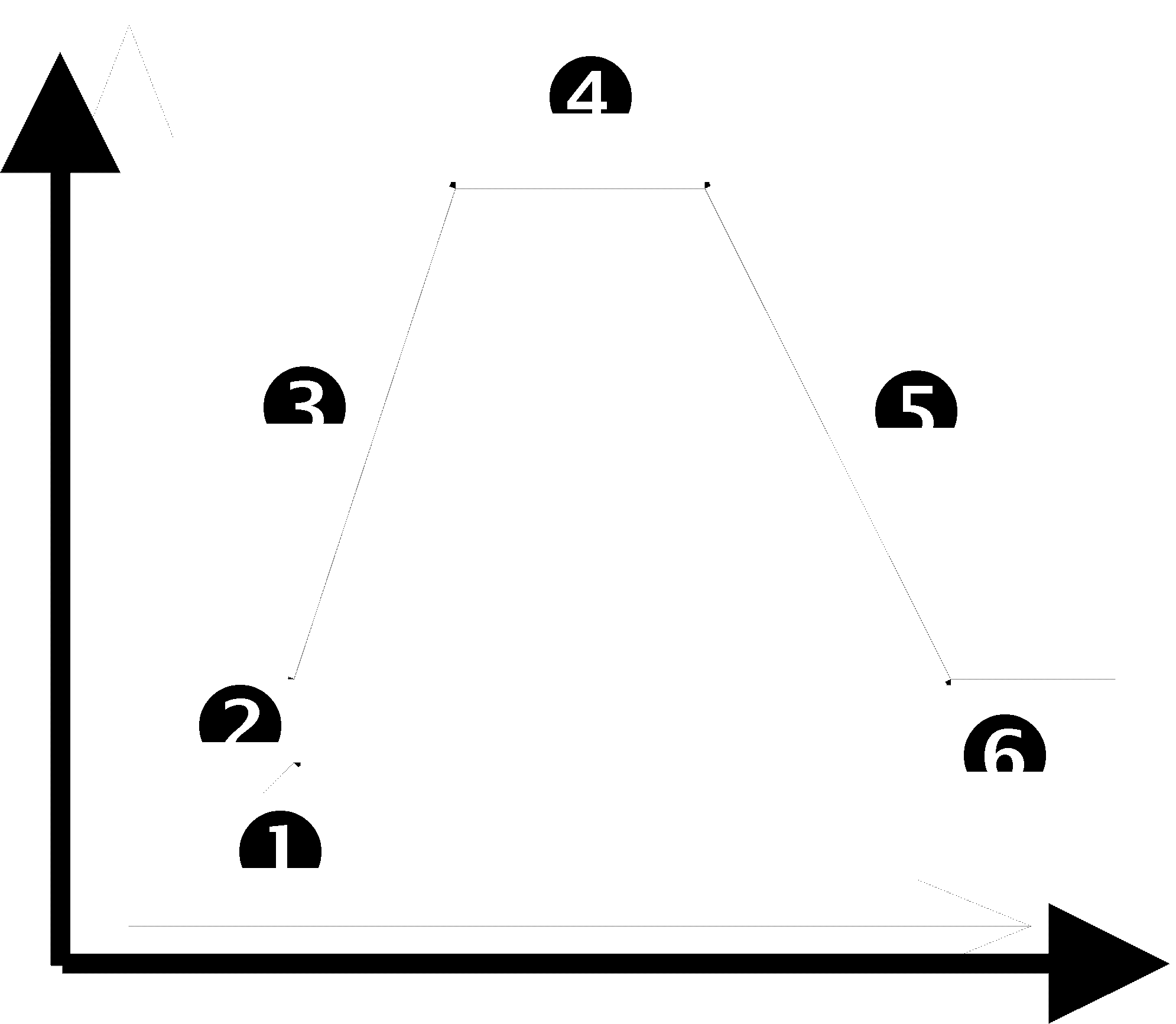
Case Study: Airplane 1. Manual attempts to fly fail. 2. Wright Brothers fly at 30mph in biplane. 3. Military use in WWI. Financial resources available. Speeds increase to 100mph. 4. Wood and rope frame aerodynamics reach limit. 5. Metal frame monoplane developed. 6. Several new types of airplanes have been developed but limited use of biplanes still exists. |
| 2. | Increasing Ideality. | ENIAC computer in 1946 weighed several tons, took a whole room, and did computational functions. In 1995, Toshiba Port�g� 610CT weighs 4.5 pounds and is capable of text processing, mathematical calculations, communications, graphics, video, sound. | |
| 3. | Uneven development of subsystems resulting in contradictions. | Subsystems have different life cycle curves. Primitive subsystems hold back development of total system. Common mistake is to focus on improving wrong subsystem. Poor aerodynamics were limitations of early planes but developers focused engine power instead of improving aerodynamics. | |
| 4. | Increasing dynamism and controllability. | Early automobiles were controlled by engine speed. Then manual gearbox, followed by automatic transmissions, and continuously variable transmissions (CVT.) | |
| 5. | Increasing complexity, followed by simplicity through integration. | Stereo music systems have evolved from adding separate components such as speakers, AM/FM radio, cassette player, CD player, etc. to integrated "boom box." | |
| 6. | Matching and mismatching of parts. |
| |
| 7. | Transition from macrosystems to microsystems using energy fields to achieve better performance or control. | Development of cooking systems from wood burning stove to gas ranges to electric ranges to microwave ovens. | |
| 8. | Decreasing human involvement with increasing automation. | Development of clothes washing from washboard to washing machine with ringer to automatic washing machine to automatic washing machine with automatic bleach and softener dispensers. | |
By analyzing the current technology level and contradictions in
our products, TRIZ can be used to see the evolutionary progress
and create the future. For example, Altshuller was able to predict
the future technology of glass plate manufacturing. The earlier
process was to roll hot glass onto a conveyor. During this process,
the glass would tend sag between the rollers resulting in waviness
in the final product. Using pattern #7, Transition from Macro
to Micro, Altshuller predicted that rollers would get smaller
and smaller until they reached the theoretical limit of atom sized.
Several years later, an English company introduced a new process
of rolling the glass out on a bath of liquid tin.
Directed Product Evolution can be used to develop patents for future technology before one's competitors.
Since TRIZ can help engineers and developers solve technical contradictions and invent new technologies, it's use in New Product Development is very important. Combined with
Quality Function Deployment (QFD), a company should be able to
identify important customer requirements and then solve any technical
bottlenecks that arise. TRIZ can also help identify new functions
and performance levels to achieve truly exciting levels of quality.
The following Table 6. shows areas where QFD and TRIZ can compliment
each other. To learn more about QFD, please refer to the books
in the reference section of this article.
| Market Research | 7 Product Planning Tools | Use Directed Product Evolution (DPE) with concept methods to show customers what new products will be like. |
| R&D | Technology Deployment | To solve engineering bottlenecks and contradictions. |
|
| Quality Deployment | To eliminate contradictions discovered by the roof of the House of Quality. |
| Help determine target values in the Quality Planning Table | ||
| Design | Function Deployment | Use Su-Field Analysis and DPE to identify new functions to excite customers. |
| Reliability Deployment | Use Anticipatory Failure Determination to identify and prevent catastrophic failure modes in new products. | |
| Concept Deployment | Use TRIZ to develop new concepts by DPE patterns in Table 5. | |
| Cost Deployment | Use TRIZ to lower costs without resorting to tradeoffs. | |
| Manufacturing | Equipment Deployment | Remove design constraints due to limitations of equipment and manufacturability. |
| Production | Process Deployment | Remove design constraints due to limitations of processes and people. |
| After Service | Service Deployment | Help in design for serviceability. Remove service bottlenecks. |
Here is a list of some of the companies that have begun studying and using TRIZ in the U.S. since 1993.
Allied Signal Aerospace Sector
Chrysler Corp.
Emerson Electric
Ford Motor Co.
General Motors Corp.
Johnson & Johnson
Rockwell International
UNISYS
Xerox Corporation
Because TRIZ is built on a database of hundreds of thousands of
patents, principles, operators, contradictions, etc. use of software
helps engineers with minimal training achieve timely results.
Here is a description of some of the software packages available.
Ideation International Inc. features two principle TRIZ scientists,
Boris Zlotin and Alla Zusman, both students of the founder of
the methodology, G.S. Altshuller. They reside in Detroit, Michigan
the automotive capital of the world. With their staff, they have
been advancing and adapting Altshuller's methods to the American
style.
Their software team has developed a number of software packages
to assist engineers in apply TRIZ to their products. Here is a
brief description of the software.
| Improver | Improve existing designs
Improve manufacturing process Improve system performance Improve system quality Improve manufacturing cost Improve patent applications Improve product features | 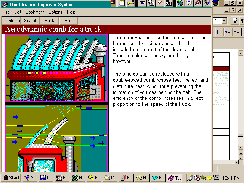 |
| Ideator | ARIZ helps you
to create abstract models of a system, including the formulation of
contradictions and envisioning of the ideal situation.
Idealization is a process used to bring your system as close to ideal as possible. Innovation Mini-Guide contains approximately 100 technical applications of physical, chemical and geometrical effects. | 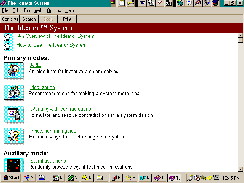
|
| Eliminator (Appetizer) | The Ideation Appetizer is designed to help you find truly elegant and innovative problem solutions without any drawbacks or trade-offs. | 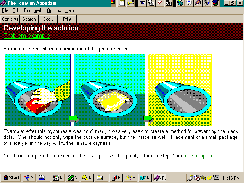 |
| Innovation Workbench TM (IWB) | 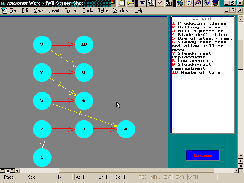
|
Altshuller, Henry. 1994. The Art of Inventing (And Suddenly
the Inventor Appeared). Translated by Lev Shulyak. Worcester,
MA: Technical Innovation Center. ISBN 0-9640740-1-X
Braham, James. "Inventive ideas grow with 'Triz.'" Machine
Design. Vol. 67 No. 18. October 12, 1995.
Ideation International. "Assessment of Invention via Utilization
of Ideation Methodology (the U.S. Adaptation of the Russian-developed
TRIZ)." Ideation International, Inc. Santa Monica, CA. Fax:
+1 (810) 353-5495.
Ideation International. "Directed Product Evolution."
Ideation International, Inc. Santa Monica, CA. Fax: +1 (810) 353-5495.
Ideation International. 1995. Ideation Methodology v.4.0 Ideation
International, Inc. Santa Monica, CA. Fax: +1 (810) 353-5495.
Ideation International. "The Process for Systematic Innovation."
Ideation International, Inc. Santa Monica, CA. Fax: +1 (810) 353-5495.
Ideation International. "TRIZ History and Background."
Ideation International, Inc. Santa Monica, CA. Fax: +1 (810) 353-5495.
Ideation International. "TRIZ/Ideation Methodology Tools
for Systematic Innovation." Ideation International, Inc.
Santa Monica, CA. Fax: +1 (810) 353-5495.
Kaplan, Stan. "An Introduction to TRIZ: The Russian Theory
of Inventive Problem Solving." Draft. Ideation International,
Inc. Santa Monica, CA. Fax: +1 (810) 353-5495.
Verduyn, David M. and Alan Wu. 1995. Integration of QFD, TRIZ,
& Robust Design: Overview & "Mountain Bike"
Case Study. ASI Total Product Development Symposium, Nov.
1-3, 1995, Dearborn, MI.
Over 20 years experience in TRIZ and engineering. Co-author of 9 books on TRIZ, including 3 with G. Altshuller, TRIZ founder. Teaching TRIZ experience over 8,000 hours. Over 6,000 hours of TRIZ consultations. Facilitated solving over 4,000 technological and business problems. Taught TRIZ to over 5,000 students. Advanced the methodology including Patterns of Evolution in different areas, US adaptation of the methodology, developing new applications such as solving scientific and business problems. Developed the theoretical base for TRIZ software products.
Over 15 years experience in TRIZ. Co-author of 7 books on TRIZ, including one with G. Altshuller, TRIZ founder. Teaching TRIZ experience over 3,000 hours. Taught TRIZ to over 3,000 students, including over 300 in US. Advanced the methodology including US adaptation of the methodology, developing new applications such as solving scientific and business problems. Developed the theoretical base for TRIZ software products.
Over 10 years of TRIZ experience as a TRIZ teacher and problem solver. Primary architect of Ideation TRIZ-based software products.
Over 20 years of experience in the design and development of micromethods in the field of molecular cell biology. Developed and taught a new course for University students entitled TRIZ-based Introduction to the Study of Biology.
Over 15 years of TRIZ experience teaching and developing TRIZ,
solving inventive problems using the methodology, and developing
TRIZ-based software products. Named inventor on eleven patents.
The information on this Web Site has been substantially provided by and used with the permission of Ideation International Inc. For more information about Ideation International, contact Mr. Zion Bar-El at Ideation International Inc., 23713 Riverside Drive, Southfield MI 48034 USA. Telephone: +1 313-353-1313. Facsimile: +1 313-353-5495. E Mail: zionb@aol.com or click here.
This page was created for viewing with Netscape
v2.0. Download the latest version of Netscape by clicking here.
Some Netscape features may not be supported by your Web Browser.
Should strange appearances occur, email me
regarding the misbehaving area along with the name and version
of the browser you are using.
Copyright � 1995 by Glenn Mazur .
All rights reserved. In the spirit
of TQM, this page is continuously improved. Suggestions can be
emailed to mailto:gmazur@engin.umich.edu or by clicking here.
Last update: February 26, 1996.
To learn more about QFD, visit my virtual QFD course pack at
the University of Michigan College of Engineering at https://www.mazur.net/tqm/tqm8.htm or by
clicking here.
For more information about TQM, click here.
This page created by Glenn Mazur.